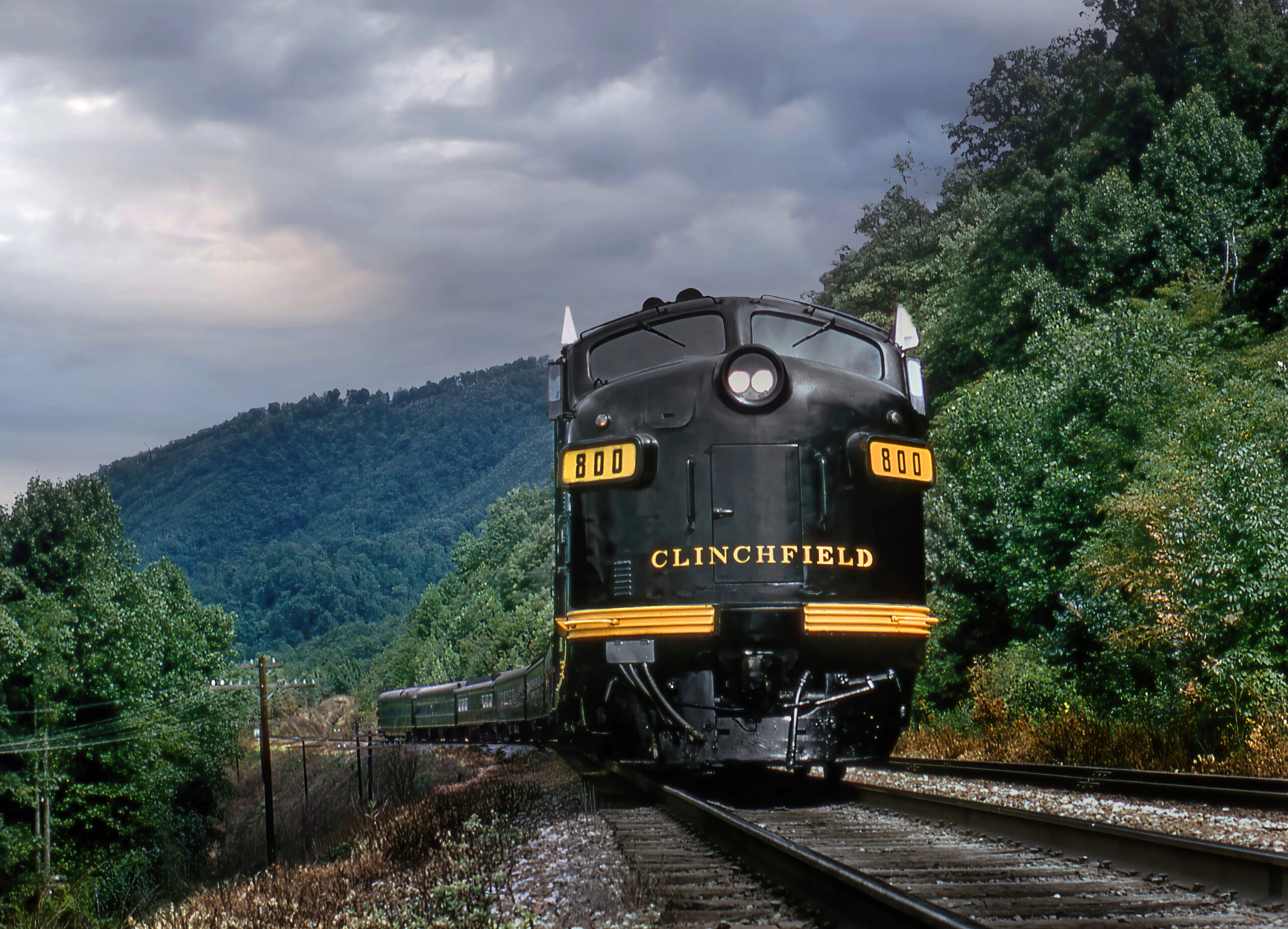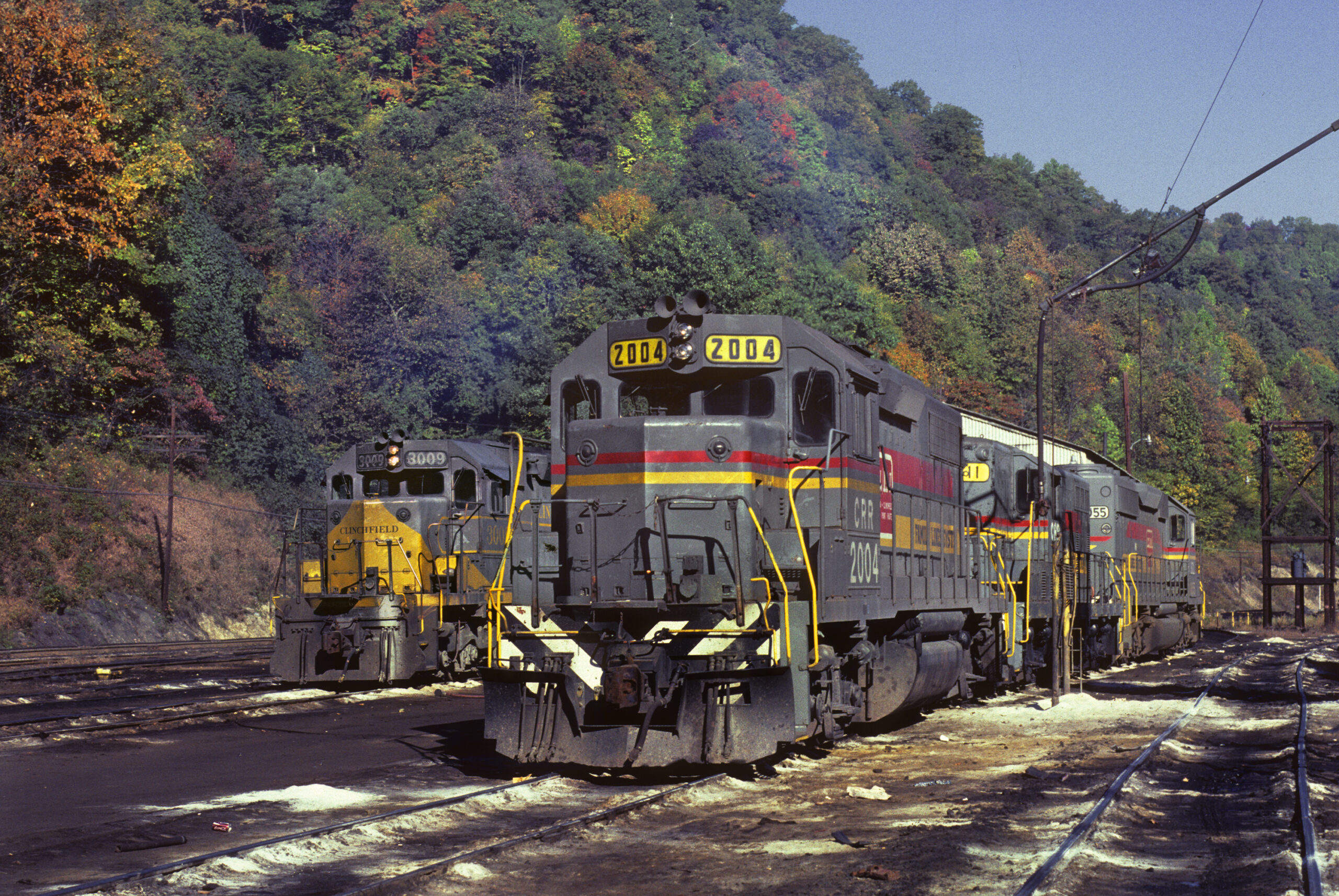A Clinchfield primer

EMD hood units await calls to work at Dante, Va., on Oct. 13, 1980. Originally known as Turkey Foot, the town was renamed Dante in 1906. Shortly after, it became a busy center for coalfield railroading. Ron Flanary
The earliest noises of building a railroad to connect Ohio with the Atlantic Ocean were made as far back as 1827, the same year the nation’s first common carrier, the Baltimore & Ohio, was chartered. Proposals are one thing but turning dirt and laying track is another matter. A charter was issued to Louisville, Cincinnati & Charleston in 1836, but it went bankrupt after completion of only 18 miles of track. Next came the Blue Ridge Railroad, but it, too, gave up the ghost after partial completion of a tunnel in the northwest corner of South Carolina after 1853.
Three decades later, after the tensions of the Civil War had eased, the Charleston, Cincinnati & Chicago — the “Triple C”— launched the most ambitious effort of all in 1886. By 1890, much of the line was completed with limited operations, and more were graded and ready for track. Alas, the Triple C was buried by the Panic of 1893. After a period of resurrection, the pieces emerged again under a new regium as the Ohio River & Charleston.
By 1902, a local businessman named George L. Carter stepped in to launch what was initially named the South & Western Railway — an intentionally ambiguous title designed to conceal his intentions. Carter developed the vast coalfields in southwestern Virginia and scrapped most of the Triple C grade in favor of construction standards almost unheard of at the time. Grades of no more than 1.5% and curves less than 10% (except in a few notable instances) were mandated. The railroad would need 55 tunnels totaling 10 track miles underground, plus several impressive steel viaducts.
Most of the tunnels were concentrated on the climb from the Piedmont region to the top of the Blue Ridge mountains at Altapass, N.C., and in the stretch of trackage north of Kingsport through the heart of the dendritic topography of the Cumberland Plateau. By 1908 he renamed the railroad the Carolina, Clinchfield & Ohio, and by 1915, the obligatory “last spike” was driven at Trammel, Va., with an aging and frail Carter in attendance.
The CC&O would later be leased jointly to the Atlantic Coast Line and Louisville & Nashville in 1924, an agreement made retroactive to 1923. The two big roads created the Clinchfield Railroad as the lessee and operating company.
The Clinchfield became the catalyst that created the city of Kingsport. Along the way the railroad also became a major player in the movement of seasonable perishables from Florida to the Midwest and mixed freight linking its major southern connections, the Atlantic Coast Line in Spartanburg, S.C., the Seaboard Air Line in Bostic, N.C., and the C&O at Elkhorn City, Ky., at the north end. Other key connections included the coal-hauling Interstate Railroad at Miller Yard, Va., (and, by virtue of trackage rights to that point, its co-parent, the L&N), the N&W at St. Paul, and some interchanges with Southern Railway and a few short line operations. The small coal mining community of Dante, Va., became the epicenter for the railroad’s service to the mines on its northern end, with mine runs placing empty hoppers and gathering loads for weighing, billing, and dispatching in coal trains, both north and south. In short, the Clinchfield became a money-making machine for the ACL and L&N.
The CC&O initially moved its trains with Consolidations and Mikados. Typical of drag freight era power, several Mallet compound 2-6-6-2s would take over the heaviest tonnage trains but were soon eclipsed by several USRA-model 2-8-8-2 Mallets. There were stretches of the railroad — particularly on the south end — where trains could really roll if motive power was up to the task. With heavy manifests routinely requiring triple-headed 2-8-2s to make schedule, the Clinchfield embraced modern steam in late 1942 with the first of an eventual fleet of 18 high-speed 4-6-6-4 Challenger-types (including the six second-hand former Rio Grande engines acquired in 1947).
Co-owner L&N would not commit to total dieselization until 1950, but the ACL made the plunge earlier — largely on the money from its control of the L&N and the Clinchfield. In 1948, the Clinchfield took delivery of its first diesel — F-unit No. 800. By the mid-1950s, steam was gone, dispatched by a modest fleet of more F-units for road freights, GP7s for mine runs and locals, and several SW7s to work yard jobs at Erwin and industrial switching jobs at Kingsport and other on-line traffic hotspots. Later motive power purchases ranged from GP38s and SD40s and SD45-2s. During the last two decades of the Clinchfield’s existence, leased and borrowed motive power was common to address a near constant shortage of units to move its trains.
ACL and L&N also supported major investments in the Clinchfield’s physical plant with heavier rail, centralized traffic control, siding extensions, and other betterments to keep the railroad up to the highest standards.
With creation of CSX Corporation in 1980, the various members of the “family” of ACL (later SCL) railroads were combined as Seaboard System in 1983 to match up with the Chessie System companies. Eventually everything was placed under CSX Transportation in 1987, an arrangement that lasts to this day. One of the first tangible changes under CSX was linkage of a former L&N branch with a C&O line at Deane, Ky., creating a through route for L&N coal from its Eastern Kentucky Subdivision to southeast US power plants via the former Clinchfield.
From that day forward until the use of thermal coal from central Appalachia began to decline significantly in the mid-2000s, the former Clinchfield route was one of the more tonnage-heavy segments on the entire CSX system (“Men Against Mountains,” October 2001 Trains). With southbound coal traffic down to a trickle — and production in its own territory from a single mine at McClure, Va., — the former Clinchfield was downgraded in 2017 with remaining through traffic diverted to other routes. That decision was later reversed, so today’s route sees several locals, at least two through mixed freights each way, ethanol, grain, and the remaining coal traffic.
The historic headquarters of the Clinchfield at Erwin, Tenn., was closed with the downgrading of a few years ago, so through crews now change at Kingsport.
Also, visit “Remembering the Clinchfield Railroad” in Classic Trains.















The photo captions are reversed…but otherwise, thanks!
Thanks Ron,
When it comes to knowledge of Appalachian railroading, you are a great resource! Keep them coming!
The coal trains off the Clinchfield that were forwarded on the C&WC are surely missed, including the CRR diesels than would run through, times change but good we have our memories!